|
|
|
Sort Order |
|
|
|
Items / Page
|
|
|
|
|
|
|
| Srl | Item |
| 1 |
ID:
160990
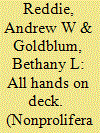

|
|
|
|
|
| Summary/Abstract |
With the continued use of unsafeguarded naval nuclear-propulsion programs in all nuclear-weapon states, the commissioning of an Indian nuclear submarine, and the potential investment in such programs by non-nuclear-weapon states including Brazil and South Korea, movement toward a regulatory regime for nuclear material in the naval sector has become imperative. Such a framework faces a recurring debate on adequately protecting sensitive military technology while delivering assurances that naval nuclear material is not diverted to nuclear-weapon programs. In this viewpoint, we examine various prospective mechanisms to regulate naval nuclear stocks and assess them in terms of their effectiveness and scope. Drawing on lessons from the drafting, negotiation, and implementation of the Model Additional Protocol, we recommend a safeguards regime for naval nuclear material via a protocol that supplements the existing global nuclear-governance system. This protocol provides a standardized yet flexible approach to naval nuclear-material safeguards across all states (whether nuclear-weapon states, non-nuclear-weapon states, or outside the Treaty on the Non-Proliferation of Nuclear Weapons) to handle variations among naval nuclear fuel cycles and technologies.
|
|
|
|
|
|
|
|
|
|
|
|
|
|
|
|
| 2 |
ID:
160986
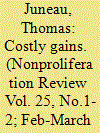

|
|
|
|
|
| Summary/Abstract |
Iran’s nuclear ambitions have been at the center of Middle Eastern politics and a global nonproliferation source of concern for almost twenty years. Much has been written on the topic, but one important question has received less attention: was it beneficial for the Islamic Republic? How have the gains and losses associated with its nuclear pursuits compared with each other? This article attempts to provide a comprehensive assessment of the costs and benefits of Iran’s nuclear program. We start with an overview of the literature on why states pursue nuclear programs. This allows us to build a list of objectives that states can hope to achieve through their nuclear ambitions. We use these as yardsticks to assess the gains Iran has reaped and the losses it has incurred. This leads to the conclusion that, although Iran has earned some benefits from its nuclear program, these have been costly; ultimately, the costs have exceeded the benefits. We conclude by reflecting on what the Iranian case tells us more broadly about the study of nuclear proliferation.
|
|
|
|
|
|
|
|
|
|
|
|
|
|
|
|
| 3 |
ID:
160997


|
|
|
|
|
| Summary/Abstract |
In connection with United Nations Security Council Resolution (UNSCR) 1540, the Federal Government of Germany, in cooperation with the United Nations Office for Disarmament and the European Commission’s Outreach in Export Controls Programme, created the “Wiesbaden Process,” a series of conferences designed to promote awareness of the goals of UNSCR 1540. National authorities organizing the regional variants of the Weisenbaden Process invite representatives of large enterprises likely to be concerned by nonproliferation topics. The benefits of these conferences never reach other stakeholders, in particular small and medium-sized enterprises (SMEs), creating an apparent gap in the implementation of UNSCR 1540. This article discusses the proposed creation of an “industry network” to further the political objectives of UNSCR 1540 and proposes general organizational rules for future Wiesbaden conferences.
|
|
|
|
|
|
|
|
|
|
|
|
|
|
|
|
| 4 |
ID:
160989
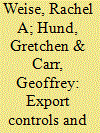

|
|
|
|
|
| Summary/Abstract |
The separation between export control and counterproliferation finance (CPF) efforts may be undermining governments’ ability to detect and stop weapons of mass destruction (WMD) proliferation. Using export-control information in screening financial transactions and using financial information in export-control decision making can be mutually reinforcing, each system feeding new information back to the other, creating a fuller picture of proliferation procurement networks. This article begins by identifying the US domestic agencies and international bodies involved in export controls and CPF, respectively, followed by a brief outline of the international and domestic sanctions regimes and export-control implementation. It then examines why financial information has historically not been considered relevant to export control and why export-control information is not regularly used to stop financial crime. The article then discusses the limitations of existing proliferation-finance guidance provided to financial institutions, as well as the problematic exclusion of marine insurance from US anti-money-laundering regulations and how it detracts from counterproliferation efforts. The authors conclude with a series of concrete options for better integrating export-control enforcement and combating proliferation finance, including options for both the US and the international community.
|
|
|
|
|
|
|
|
|
|
|
|
|
|
|
|
| 5 |
ID:
160987
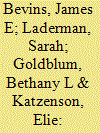

|
|
|
|
|
| Summary/Abstract |
While the nonproliferation community has long acknowledged the possibility of nuclear terrorism, its prevention has become a central focus area in recent years. For decades it has been assumed that, with access to special nuclear material (SNM), the steps to indigenously develop an improvised nuclear device are within the reach of non-state actors. At the same time, indigenous production of SNM has generally been dismissed as infeasible. Recognizing how recent trends of technology democratization, the open exchange of information, and globalization have eroded certain barriers to proliferation by non-state actors, this research explores the pathways a non-state actor could take to indigenously develop SNM and develops a method to determine the comparative attractiveness of each pathway, given the current capabilities of non-state actors. Additionally, it considers avenues for further investigation to identify countermeasures for SNM production, including countermeasures specific to non-state actors.
|
|
|
|
|
|
|
|
|
|
|
|
|
|
|
|
| 6 |
ID:
160980
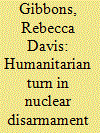

|
|
|
|
|
| Summary/Abstract |
On July 7, 2017, at the UN General Assembly, 122 states voted to adopt the Treaty on the Prohibition of Nuclear Weapons. This was the culmination of the work of a global network of states and grassroots activists that emphasized the devastating humanitarian consequences of nuclear-weapons use in order to delegitimize their possession. Advocates of the ban treaty are frustrated with the slow pace of nuclear disarmament through traditional channels. This article traces the history of the ban movement from 2005 to the present. It concludes by highlighting six factors that led to the successful adoption of the treaty: a small group of committed diplomats; an influx of new coalition members; the contribution of civil society; the reframing of the narrative surrounding nuclear weapons; the pursuit of a simple ban treaty; and the context provided by the Barack Obama administration.
|
|
|
|
|
|
|
|
|
|
|
|
|
|
|
|
| 7 |
ID:
160982
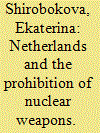

|
|
|
|
|
| Summary/Abstract |
On July 7, 2017, the United Nations conference to negotiate a legally binding instrument to prohibit nuclear weapons concluded with the adoption of the Treaty on the Prohibition of Nuclear Weapons (TPNW), which opened for signatures at the United Nations General Assembly two months later, on September 20. The nuclear-weapon states and their allies boycotted the negotiations with the sole exception of the Netherlands, which not only is a member of NATO, but also hosts US nuclear weapons on its territory. Domestic pressure and political traditions had significant effects on the Dutch government’s decision to participate in the ban negotiations. The Netherlands negotiated in good faith, but its multilateralism and humanitarian considerations could not tip the scales in favor of joining the ban treaty. The government’s commitment to a “step–by–step” approach to nuclear disarmament and maintenance of close cooperation with NATO determined the Dutch position on the new instrument. Despite staying outside the TPNW, the Dutch government shares the goal of nuclear-weapons elimination. This article also suggests a number of actions the Netherlands could take to advance nuclear disarmament.
|
|
|
|
|
|
|
|
|
|
|
|
|
|
|
|
| 8 |
ID:
160984
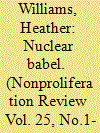

|
|
|
|
|
| Summary/Abstract |
The 2017 Treaty on the Prohibition of Nuclear Weapons has been successful in starting new conversations about nuclear weapons. Unfortunately, many of those conversations are happening in silos with ban supporters and opponents talking past each other. Both sides of the debate often misrepresent one another, putting at risk cooperation within the global nuclear order and progress toward the 2020 Nuclear Non-Proliferation Treaty Review Conference. To address these misperceptions, this article offers a bridge-building framework with steps for nuclear-weapon states, ban supporters, and regional and political coalitions. The framework is designed to be practical and to build trust following a heated and controversial debate around the ban treaty and its predecessor, the humanitarian impacts of nuclear weapons movement. The most important and timely of these efforts is for ban supporters and opponents to work together on risk reduction at a time of heightened geopolitical tensions with rising risks of misperception and inadvertent escalation.
|
|
|
|
|
|
|
|
|
|
|
|
|
|
|
|
| 9 |
ID:
160985
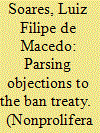

|
|
|
|
|
| Summary/Abstract |
The Secretary-General of the Agency for the Prohibition of Nuclear Weapons in Latin America and the Caribbean (OPANAL) rejects the argument of those opposed to the 2017 Treaty on the Prohibition of Nuclear Weapons that the treaty undermines the 1968 Treaty on the Non-Proliferation of Nuclear Weapons. This viewpoint is based upon Ambassador Soares’s statement to the conference, “Regional Consultations on the NPT: Towards the 2018 PrepCom,” held in Mexico City, February 15, 2018.
|
|
|
|
|
|
|
|
|
|
|
|
|
|
|
|
| 10 |
ID:
160988
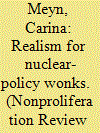

|
|
|
|
|
| Summary/Abstract |
In the United States, the nuclear-policy community considers the realist school of thought the gold standard of analytical excellence. Sometimes equated with theories of nuclear strategy and massive retaliation, sometimes with the inter-war intellectual debate on how to respond to the rise of fascist militarism in Europe, the distinction between realism and idealism effectively predetermines the positions and analytical arguments available for a new generation of policy professionals. This, in turn, leads to a repetitive and theoretically stale debate between the nation’s foremost experts on technical and ethical matters of national interest. In order to stake out a new conceptual baseline for future policy discussions, this article suggests that it would be useful for nuclear-policy analysts to reacquaint themselves with the content and rhetorical strategies of classical realism in order to, firstly, enable a more humble and sociologically oriented form of nuclear-policy analysis and, secondly, make possible a new substantive debate beyond the narrow confines of neorealism on the one hand and classical nuclear strategy on the other. In making this argument, I am combining insights from my own ethnographic fieldwork among Washington’s nuclear-policy elites, recent contextualist scholarship on classical realism, and critical theoretical analyses of the deeper social forces shaping US nuclear-policy making.
|
|
|
|
|
|
|
|
|
|
|
|
|
|
|
|
|
|
|
|
|